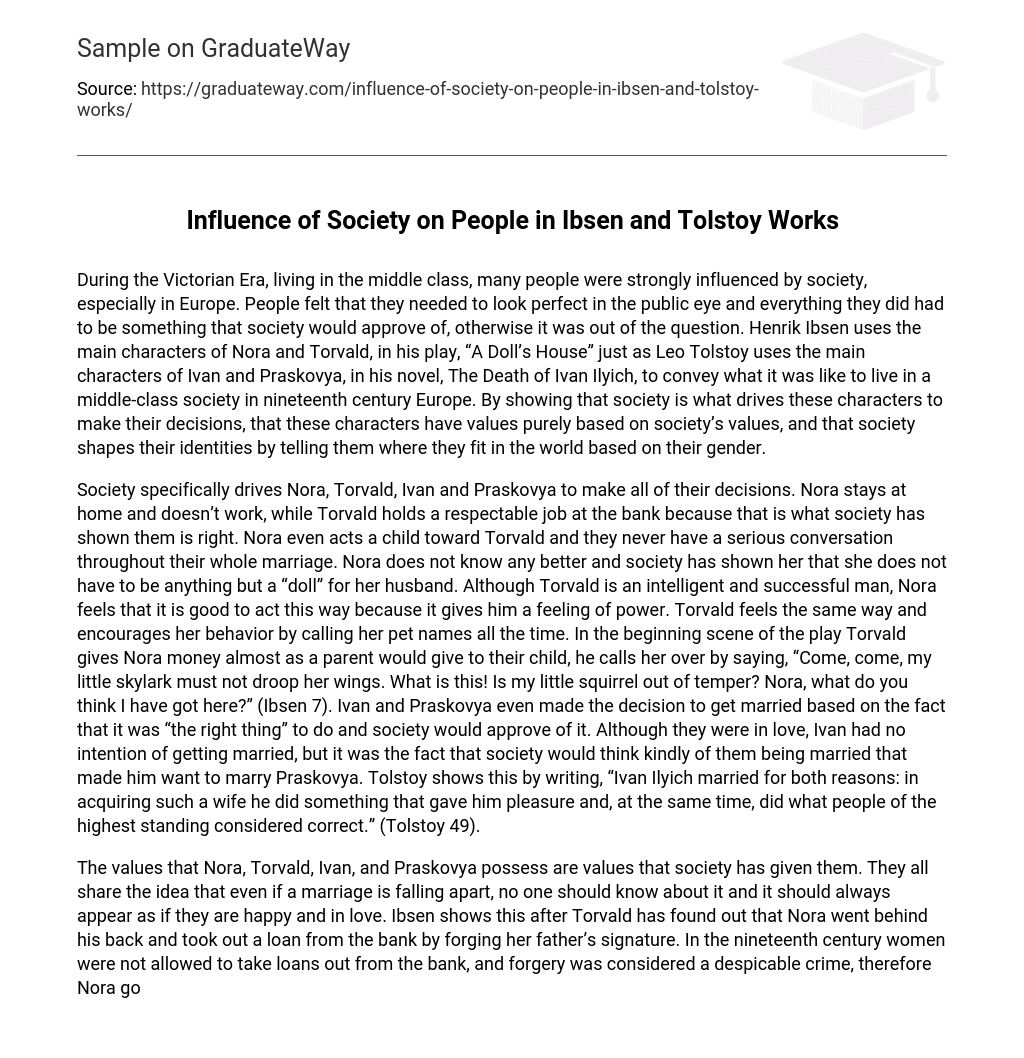During the Victorian Era, individuals in the middle class were heavily influenced by societal norms, particularly in Europe. It was crucial for people to present themselves flawlessly in public, and their actions had to align with societal approval. Henrik Ibsen’s play, “A Doll’s House,” and Leo Tolstoy’s novel, “The Death of Ivan Ilyich,” depict the experiences of individuals living in nineteenth century European middle-class society through their main characters. These authors demonstrate that societal expectations drive the characters’ decision-making process, that their values are solely derived from society’s values, and that society molds their identities by dictating where they stand in the world based on their gender.
The decisions made by Nora, Torvald, Ivan, and Praskovya are all driven by society. Nora conforms to societal norms by staying at home and not working, while Torvald holds a respectable job in the bank. Society has taught Nora that she should only be a “doll” for her husband and she acts like a child towards him. Even though Torvald is intelligent and successful, he encourages Nora’s behavior by using pet names. In the beginning scene, Torvald gives Nora money like a parent giving to a child and calls her names like “skylark” and “squirrel.” Similarly, Ivan and Praskovya decide to get married because society would approve of it, even though Ivan initially had no intention of marrying. Society’s approval is what motivates them to marry.Tolstoy illustrates this point through his writing, as he states, “Ivan Ilyich married for two reasons – to fulfill his personal desires and to conform to societal expectations of those in the highest ranks.” (Tolstoy 49).
The values possessed by Nora, Torvald, Ivan, and Praskovya are societal values. They all adhere to the belief that even if their marriages are falling apart, they must maintain the appearance of happiness and love. Ibsen demonstrates this when Torvald discovers that Nora secretly took out a loan from the bank by forging her father’s signature. In the 19th century, women were not allowed to obtain loans from banks, and forgery was seen as a dishonorable crime. Thus, Nora goes against Torvald’s values by committing this act. Despite Torvald no longer trusting her and wanting to keep her away from their children to prevent her corrupting them, he insists that “The matter must be hushed up at any cost. And as for you and me, it must appear as if everything between us were just as before – but naturally only in the eyes of the world” (Ibsen 77). After Ivan realizes that marriage is not always easy and he can no longer live a carefree life, he withdraws emotionally from his wife and family. However, he never considers leaving them or showing anyone that he is unhappy. This exemplifies his shared value with Torvald – prioritizing appearances over happiness. Tolstoy illustrates this by stating, “Of married life, he desired only its conveniences – having dinners at home, maintaining a well-managed household, having a partner in bed, and above all, maintaining a veneer of respectability as required by public opinion” (50).Both Nora and Torvold, as well as Ivan and Praskovya, believe in the importance of having assistance within their households. During the Victorian era, the number of household staff one possessed was seen as a measure of their success and level of respect. For instance, Nora and Torvold employed a nanny for their children, while Ivan and Praskovya had the support of a butler and pantry boy, who played a significant role in Ivan’s life during his final weeks.
Gender played a significant role in shaping the identities of Nora, Torvald, Ivan, and Praskovya. Society had clear expectations for men and women. Men were expected to be providers and have respectable jobs to meet the family’s financial needs. On the other hand, women were expected to stay at home and take care of their husbands and children. Nora and Torvald exemplified these societal norms, with Nora managing the household while Torvald worked at the bank. However, when Nora took out a loan without anyone’s knowledge, it went against society’s views and infuriated Torvald. He feared that their reputation would be destroyed if anyone found out, as it would imply a deviation from their assigned gender roles. This led him to express his anger and disappointment towards Nora. Similarly, Ivan and Praskovya adhered to these gender expectations, with Ivan striving to provide for his family and often using work as an escape.In the story, Ivan eagerly anticipated a promotion but was passed over for another man. This caused Ivan to feel intense anger and a sense of being persecuted. During the nineteenth century in Europe, it was uncommon for men to openly struggle or for their struggles to be acknowledged. Tolstoy highlights this by stating, “He alone knew that the injustices he had suffered, his wife’s constant nagging, and the debts he had accumulated by living beyond his means were not normal for someone in his position” (54).
The works “A Doll’s House” by Henrik Ibsen and The Death of Ivan Ilyich by Leo Tolstoy demonstrate the profound impact of society on individuals’ decisions, values, and gender-based identities in 19th century Europe. Society played a crucial role in shaping Nora and Torvald’s behavior and choices during their marriage, as well as influencing Ivan’s decision to marry Praskovya. Additionally, societal norms compelled both couples to uphold the appearance of a perfect marriage, regardless of the true circumstances within their homes. Lastly, society strongly dictated that men like Torvald and Ivan should bear the primary responsibility for providing for their families, while women were expected to focus solely on their children and husband’s needs.
Works Cited
Ibsen, Henrik. A Doll’s House. New York: Pocket Books, 2005. 5- 88. Print.
Leo Tolstoy’s “The Death of Ivan Ilyich” was published in 1981 by Bantam Dell. The book spans from page 39 to page 113 and is available in print format.





